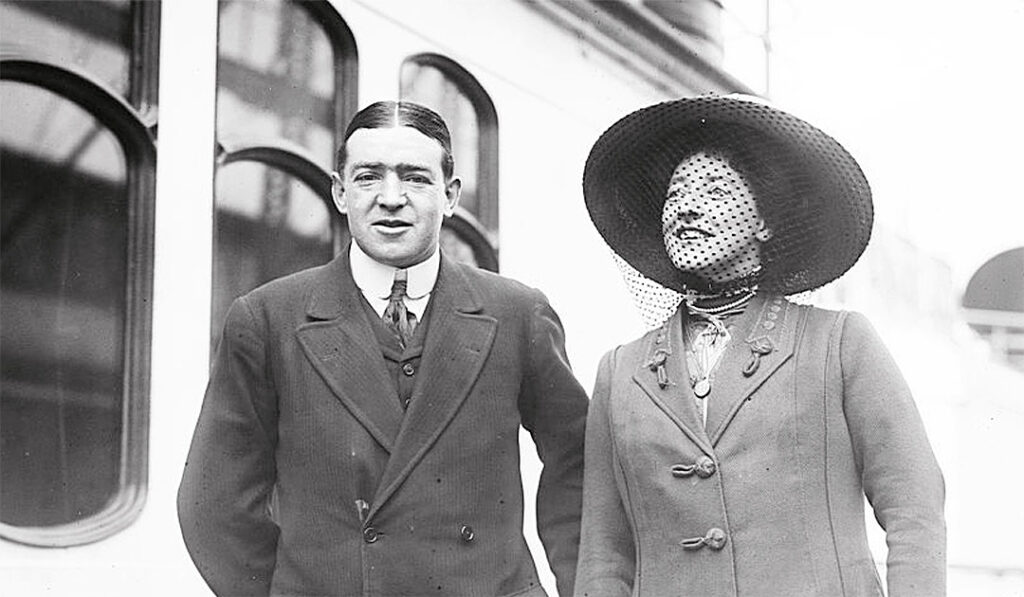
Of all the heroes of the Golden Age of Antarctic exploration (1897-1922), the name Ernest Shackleton shines brightest. Although he was the big loser next to true pioneers like Amundsen, Scott or Peary: On all of his four expeditions – three under his command – he did not reach his destination or arrived too late. His heroic deed, however, was to bring his people and himself home from the most hopeless situations. Talk about getting out of a really big mess, getting everyone out in one piece. Not all of them in one piece, but at least all of them alive, that’s what Shackleton managed to do – a masterpiece. No wonder, his motivational methods are preached at manager seminars today.
Shackleton is also said to have been a charmer and brilliant swashbuckler, a ravishing orator, everybody’s darling. Actually, Ernest should be more famous as a poet than as a polar explorer, because in this field he succeeded. The letters to his wife Emily Dorman are gems of poetry and romance. His vows of love are of such exuberance and fervor that you first wipe away a tear of emotion and then soon wonder who this much-vaunted Emily is. She must have been a heroine also, according to the wisdom that behind every great man is a strong woman. Unfortunately, an almost forgotten one. While Ernest Shackleton’s life and writings, voyages and deeds fill entire libraries, the facts about Mrs. Shackleton are thin. Like Odysseus’ faithful wife Penelope, Emily Shackleton, née Dorman (1868 in Kent) waited at home for years until her hero came home victorious from the end of the world. Such at-home women do not go down in history. In the case of Emily Shackleton, too bad, because she did some heroic things too.

A first boldness in her time: she married at the “high” age of 36, this adventurer and wanderlust sufferer who was seven years younger, with a penchant for extremes and an urge for the Poles. The two offspring from educated, good families had met much earlier, in 1897. Ernest had recognized in Emily immediately the love of his life, his vows and praises were from now on only for her. She long appeared unimpressed by his charm and glittering reports. He’d seen a lot of the world as a member of the merchant marine: Asia, China. And from 1901 he was away for a while, on Robert Falcon Scott’s Discovery expedition. A fatal voyage that cost Scott his ship, his dogs, his health and his friendship with Shackleton. In the summer of 1903 Ernest returned home to England and immediately went on a lecture tour.
In order to offer his future wife not only fine words but also a livelihood, he took a job that was not very palatable to him: secretary and treasurer of the Royal Scottish Geographical Society, in short: an office job. And this to a free spirit like Shack, as his friends used to call him.
At least: private life was soon at its peak, Ernest and Emily married in April 1904, a year later their son Raymond was born, followed by Cecily and Edward. The domestic happiness did not last long. The proud father lost his way in several ventures, failed as a politician, secretary, speculator, and again felt those bumblebees in his backside, travel fever, the urge to explore, the desire to discover, the ambition “to make a name for myself and you (Emily, who else?)”. Regardless of the thin financial cover, Ernest dreamed of a next expedition of his own. And the next. And another one.

How she managed to support herself and her three children while her husband went off into the unknown, we don’t really know. Twice the once glorious names of his expeditions became synonyms of failure: Nimrod and Endurance. The Quest expedition was to be his last. Shackleton died of a heart attack in Grytviken, South Georgia, on January 5, 1922, and was buried there at his wife’s request. In addition to his three children and ardent love letters, he also left his Emily debts amounting to the equivalent of 1.8 million euros. After all, his biography sold like hotcakes, with the proceeds going to his wife and children. Emily proved a last heroic renunciation and a lion’s heart by agreeing to have Ernest buried not in England and buried at home, but at Grytviken on South Georgia. He gets a lot of visitors and admiration there: everyone who lands in Grytviken on their way to Antarctica pays their respects at the grave with a vodka, whisky or rum. Let him remain eternally in our memory. And his Emily, too.





